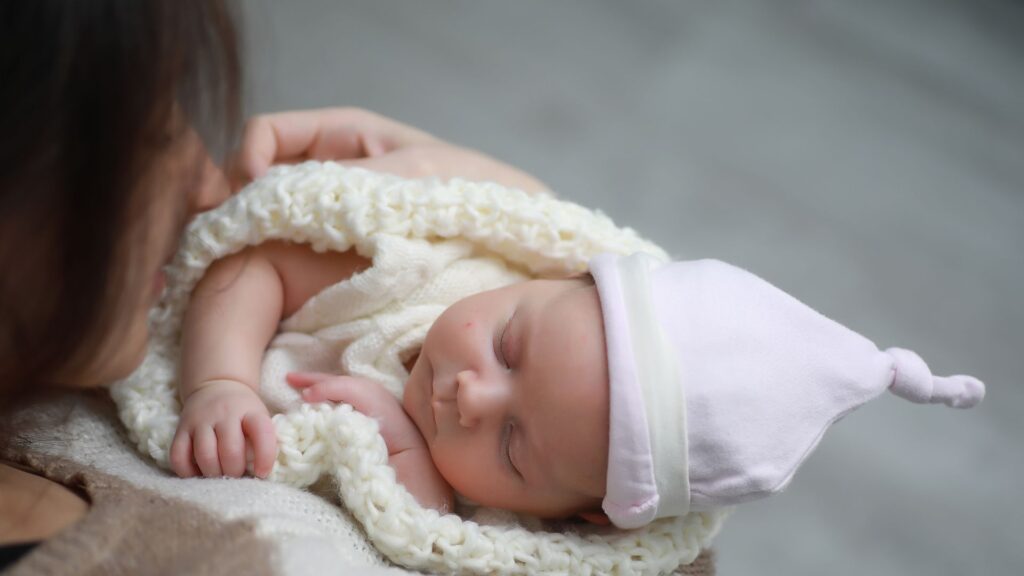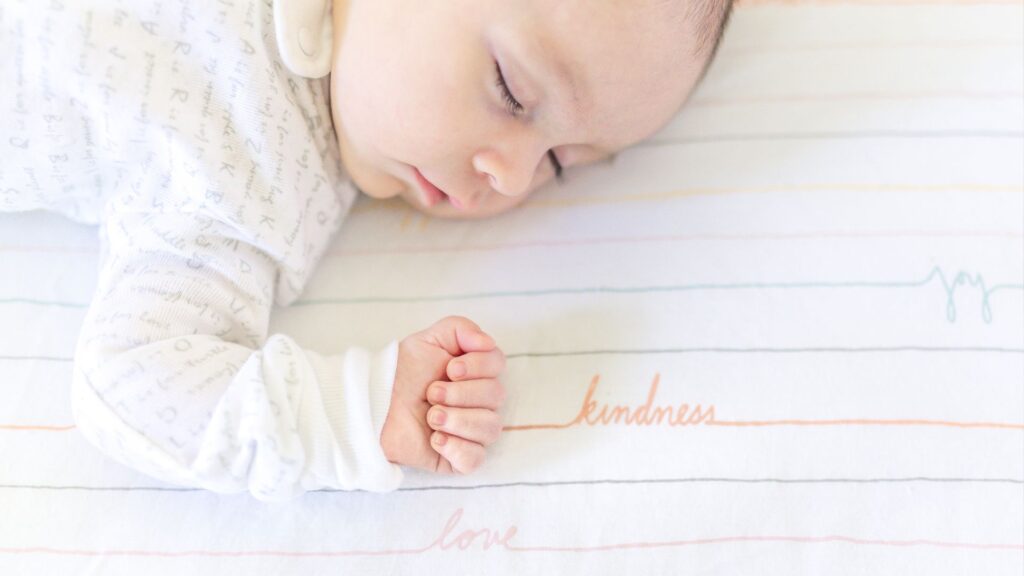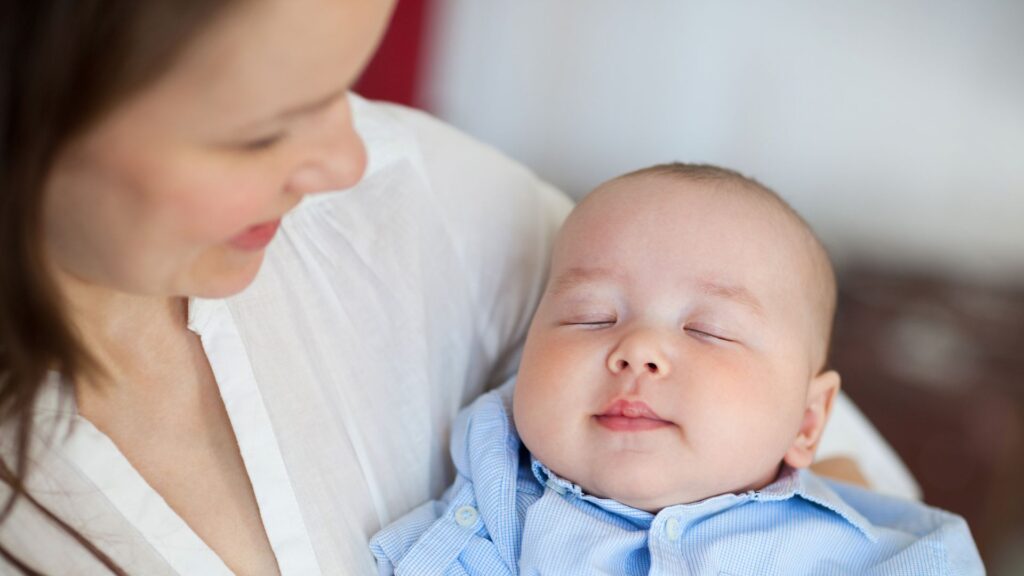Does your newborn only sleeps when held? You’re not alone. You’re not alone in this struggle. In this blog post, you’ll discover why newborns naturally are inclined to be held and learn practical techniques for teaching your baby to sleep independently.
Short Summary
- Holding your newborn close gives them a sense of security and comfort, aiding better sleep.
- Establishing a consistent bedtime routine & utilizing swaddling/sleep sacks can help babies to self-soothe and fall asleep independently.
- Take shifts with your partner, practice babywearing & prioritize self-care for successful parenting!
Understanding Why Newborns Prefer Being Held

Newborns often crave the warmth and comfort of their parent’s arms. Being held close provides comfort, security, and familiarity, reminding them of the peaceful environment they enjoyed for nine months in the womb. So when your newborn only naps in your arms or instantly wakes up and cries when you try to put them down, remember, it’s because they’re seeking a sense of safety and security. This is a common behavior among newborn babies.
The womb was a snug environment where they could hear the comforting sound of your heartbeat and feel the gentle rhythm of your breathing. As a result, being held close to your chest recreates this familiar environment, helping them feel safe and secure, often leading to better sleep.
Comfort and Security
Being held close offers babies a wonderful sense of security. It replicates the sensation they experienced in the womb, providing warmth and triggering the Moro reflex, which can contribute to establishing a sleep schedule. The physical closeness and warmth of their parents’ arms make newborns feel safe and protected. This sense of comfort and security can be especially beneficial when your newborn only naps while being held, helping them achieve better babies sleep and sleep longer.
To ensure a safe and comfortable sleep space for your newborn, you can choose the right sleeping surface, maintain the right room temperature and lighting, and reduce the risk of Sudden Infant Death Syndrome (SIDS), even when the baby refuses to sleep without being held. These measures provide additional security and comfort, enhancing your baby’s sleep quality and duration.
Womb Environment Familiarity
In the womb, babies experience a warm, dark, quiet environment with consistent rhythmic movement. This environment is also remarkably sterile. Being held can replicate these sensations, creating a similarly comforting environment that can improve newborn sleep.
If you’ve ever noticed that your baby falls asleep more easily in a swaddle blanket or while being rocked, these sensations mimic the familiar environment of the womb. This familiarity can help soothe your baby, making them feel secure and relaxed and promoting better sleep.
Transitioning to the Outside World
Being held can provide a sense of stability for newborns as they transition from the womb to the outside world, helping them adjust to their new environment. This transition can be quite overwhelming for your little one, and being held provides them with a comforting constant in a world full of new sights, sounds, and sensations.
However, knowing the risks associated with a baby sleeping in a parent’s arms is important. As comforting as it may be for your baby, it’s essential to create a safe and comfortable sleep space for them to transition to, which helps them develop healthy sleep habits.
Techniques to Encourage Independent Sleep

While understanding why your newborn prefers being held is important, it’s equally crucial to equip yourself with techniques to encourage independent sleep. After all, teaching your little one to self-soothe and fall asleep on their own is a valuable skill that will benefit them (and you!) in the long run.
From establishing a consistent bedtime routine to swaddling and using white noise, there are many strategies you can use to help your newborn develop independent sleeping habits. Transitioning away from being held to sleep allows for precious cuddles during their bedtime or naptime routine and teaches them how to drift off to sleep independently.
Establishing a Bedtime Routine
Establishing a consistent bedtime routine for your newborn can help signal them that it’s time for sleep and foster healthy sleep habits.
Setting up a bedtime routine can lead to faster sleep onset, longer sleep duration, and better sleep quality. It can also give your baby a feeling of safety and help them relax and settle down.
The routine could include a warm bath, a gentle massage, or a lullaby before bed. Consistency is key. Over time, your newborn will associate these activities with sleep, making it easier to understand when it’s time to wind down and fall asleep.
Swaddling and Sleep Sacks
Swaddling and sleep sacks are another effective way to help your newborn sleep independently. These tools provide a cozy, safe feeling for newborns, like the womb environment, helping them feel relaxed and secure as they drift off to sleep.
Swaddling helps recreate the secure and comforting environment that babies experience in the womb, which can help them feel more relaxed and activate their calming reflex. Additionally, swaddling can prevent the startle reflex, an involuntary movement that can wake a sleeping baby, by keeping the baby’s arms and legs snugly wrapped, helping to ensure a peaceful night’s sleep.
White Noise and Soothing Sounds
White noise and soothing sounds can be incredibly beneficial for newborns, allowing them to drift off to sleep more quickly and stay asleep longer. These sounds create a calming and secure environment and reduce the risk of SIDS by reducing active sleep.
White noise machines or apps can help soothe a newborn and provide the perfect environment for them to drift off to sleep independently. The gentle, consistent sound is reminiscent of the background noise they heard in the womb, providing comfort and familiarity as they adjust to their new world.
Creating a Safe and Comfortable Sleep Space

While comforting your newborn and helping them feel secure is vital, creating a safe and comfortable sleep space is equally important. The right environment can provide your newborn with security and comfort.
Whether it’s choosing the right sleeping surface, maintaining a proper room temperature, or considering the lighting in the room, all these elements can contribute to creating a conducive environment for your newborn to sleep safely and comfortably.
Choosing the Right Sleeping Surface
The sleeping surface your newborn sleeps on plays a significant role in their comfort and safety. It should be firm, flat, and meet the Consumer Product Safety Commission (CPSC) safety standards. It’s best to use a crib, bassinet, or portable play yard with a fitted sheet and avoid any soft objects in the sleeping area.
Choosing the right sleeping surface, like a bassinet or crib, can help your newborn feel more comfortable and secure. Remember, safety and comfort should always be your primary considerations when selecting the perfect sleeping surface for your newborn.
Room Temperature and Lighting
The room temperature and lighting also play a crucial role in creating a conducive sleep environment for your newborn. The ideal room temperature for newborns is between 68°F and 72°F (20°C to 22.2°C), ensuring that the baby is kept warm and comfortable. Too hot or too cold, your little one may struggle to fall asleep or stay asleep.
As for lighting, it should be dim and cozy for the baby. Blackout curtains can be incredibly beneficial in helping a baby learn the difference between nighttime and daytime. They can block out sunlight during naps, ensuring a dark and serene environment conducive to sleep.
Gradual Transition Strategies

Transitioning your newborn to sleep independently is a gradual process that requires patience and persistence. It’s about teaching your little one to self-soothe and baby fall asleep on their own, a valuable skill that will serve them well as they grow.
From the drowsy but awake technique to various sleep training methods, there are several strategies to guide your newborn toward independent sleep. Remember, every baby is unique, and what works for one may not work for another. So, it’s all about finding the right approach for your baby.
Drowsy but Awake Technique
The drowsy but awake technique is a great way to help your baby learn to fall asleep on their own. It’s about putting your baby down when they are drowsy but still awake, allowing them to learn how to self-soothe and eventually fall asleep independently without falling asleep in your arms.
To maximize success with this technique, patience and consistency are key. Recognizing when your baby is drowsy but not fully asleep and gradually increasing the awake time before they are put down for sleep are critical steps in this process.
Sleep Training Methods
Sleep training is another effective method to help your newborn learn to sleep independently. There are various sleep training methods, such as the Ferber method, the cry-it-out method, the chair method, the bedtime fading method, and the pick-up put-down method.
Each of these methods involves teaching your baby to self-soothe and fall asleep on their own, but they differ in their approach. Some methods involve gradually increasing the time between comforting your baby, while others involve allowing your baby to cry for a set amount of time before comforting them.
Patience and Persistence
Helping your newborn learn to sleep independently requires patience and persistence. It may take time for them to adjust, but by being consistent and trying different strategies, including understanding their sleep association, you can help them develop healthy sleep habits and improve their baby’s sleep.
Remember, every baby is unique and adjusts at their own pace. So, while it might be challenging at first, your patience and persistence will eventually pay off, leading to better baby sleep for both you and your little one.
Coping Strategies for Parents
As parents, it can be challenging to navigate the journey of helping your newborn sleep independently. The process can be demanding and sometimes overwhelming, from sleepless nights to managing your baby’s distress. But remember, you’re not alone in this journey, and there are effective coping strategies to help.
Taking shifts with your partner, utilizing babywearing, practicing self-care and seeking support are all strategies that can help you cope and make the process easier for both you and your baby.
Taking Shifts with Your Partner
Taking shifts with your partner can be an effective way of ensuring both of you get some rest. This strategy allows you to share the responsibility of caring for your baby, ensuring that both of you are better equipped to handle the challenges of a newborn.
It’s important to communicate openly and be flexible with each other to ensure successful shift-taking. Whether it’s taking turns sleeping during the day, caring for the baby at night, or having one parent take the night shift while the other takes the day shift, find what works best for both of you.
Utilizing Babywearing
Babywearing is another great strategy that can be incredibly beneficial for both you and your baby. Wearing your baby in a baby wrap allows you to tend to other tasks while providing your baby with the comforting feeling of being held close.
When babywearing, ensure both you and your baby are comfortable and safe. Use a carrier designed for your baby’s age and size, and always follow the manufacturer’s instructions for use and safety. This can provide both comfort for your baby and hands-free convenience for you.
Self-Care and Support
Finally, remember to prioritize self-care and seek support when needed. Caring for a newborn can be exhausting, and it’s important to take care of yourself too. Whether it’s taking a short break, practicing mindfulness, or simply taking a moment to breathe, self-care is essential.
Don’t hesitate to reach out for help from friends, family, or professionals. Whether it’s help with tasks like grocery shopping or meal prep, or simply needing someone to talk to, support can be invaluable during this time.
Conclusion
In this blog post, we’ve explored why newborns prefer being held, how to encourage independent sleep, and coping strategies for parents. We’ve learned that being held provides newborns with a sense of comfort, security, and familiarity and that techniques like establishing a bedtime routine, swaddling, and using white noise can encourage independent sleep.
Remember, transitioning your newborn to sleep independently is a gradual process that requires patience and persistence. But with the right strategies and a supportive environment, you can guide your newborn toward better sleep habits. Remember, every baby is unique, and what works for one may not work for another. So, be patient, be persistent, and most importantly, trust your instincts. You’ve got this!
Frequently Asked Questions
How do you help a baby who only sleeps when held?
Swaddle your baby, use rumbly white noise, rock them, offer a pacifier, lay them down awake and understand their wake windows to help your baby sleep without being held. Conquer reflux if it is an issue.
Why do newborns prefer being held?
Newborns prefer being held as it provides comfort, security, and familiarity similar to their time in the womb.
Holding a newborn can help them feel safe and secure, as it replicates the environment they were used to in the womb. It can also help them feel more familiar and comfortable in their new environment.
What is a safe and comfortable sleep space for my newborn?
Create a safe and comfortable sleep space for your newborn by ensuring a firm, flat sleeping surface that meets CPSC safety standards, a room temperature between 68°F and 72°F, and dim, cozy lighting – for a restful night’s sleep.
This will help your baby get the restful sleep they need to grow and develop.
How can I cope with the stress of helping my newborn sleep independently?
Taking shifts with your partner, utilizing babywearing, and practicing self-care and seeking support can help you cope with the stress of helping your newborn sleep independently.
Hi – I’m Alina and I am a soon to be mom going through the journey of becoming a parent. I am a writer at heart and I love sharing about pregnancy tips and other busy mom hacks.
